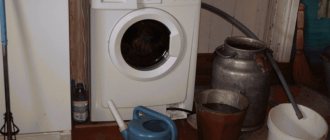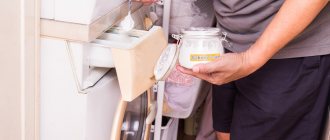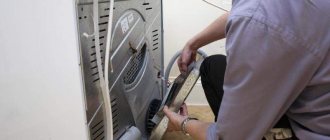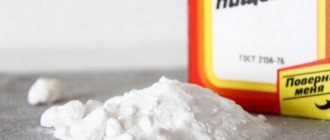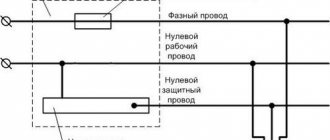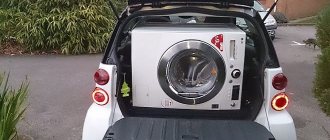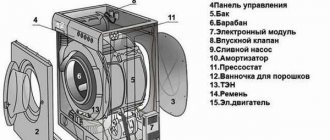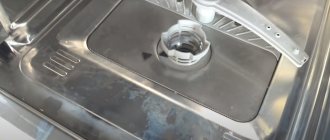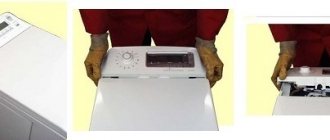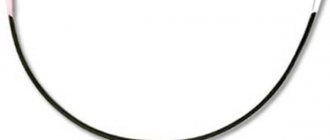Today, a washing machine can be found in almost every home. It saves a lot of time and makes our life easier. But this hardworking assistant periodically needs to be cleaned to remove scale and unpleasant odors. To remove them, experts recommend using advertised chemical cleaners. We would like to draw your attention to household products that are easy to use at home. An indispensable assistant in this matter is an effective natural and, importantly, inexpensive remedy, proven over decades - vinegar! Its main advantages:
- accessibility, always “at hand”;
- antibacterial and disinfectant properties;
- perfectly removes scale:
- safety for both humans and the parts of the washing machine.
In this article we will tell you how to quickly clean an automatic washing machine with vinegar. It will easily and carefully free all parts inside the machine from dirt.
Causes of scale and unpleasant odor
The main reason for the formation of scale: “hard” water containing calcium and magnesium salts dissolved in it. During washing, calcium and magnesium compounds decompose into carbon dioxide and insoluble sediment - lime deposits that stick to machine parts and heating elements. This is how scale forms on the heating element. Unfortunately, the quality of our tap water makes it impossible to prevent the appearance of limescale.
Colonies of microorganisms and mold are the source of unpleasant odors. Comfortable conditions for their reproduction:
- Mold on the drum and heating element appears at high humidity and low temperature. “Short” washing programs at temperatures below 40 degrees should be avoided as much as possible;
- Crumbs and pieces of paper remaining in clothing pockets sticking to the walls of the drum serve as food and a basis for colonies of bacteria and mold. It is imperative to remove these small particles from the drum and wipe its surface;
- Residues of powder and conditioner in the detergent container, as well as water at the bottom of the drum, are a favorable environment for the growth of bacteria and mold. After washing, these parts must be wiped dry;
- Mold may appear on the damp rubber sealing ring around the hatch - after finishing washing, the ring must be wiped of moisture.
- Small particles of dirt and pieces of rust from the water settle on the filter and form the basis for the accumulation of bacteria and mold. It is necessary to regularly clean the filter and promptly replace it with a new one.
NOTE! To increase the service life of the device, immediately after washing clothes, rinse and wipe dry the inner surface of the tank, the detergent container, and regularly clean the filters. It is better to keep the loading hatch door slightly open for natural ventilation in the washing machine.
But places such as heating elements with a deposit of washing powder and scale formed on them, and other surfaces of the internal parts of the machine are inaccessible for manual cleaning and rinsing.
Regular table vinegar will help solve this problem without much difficulty.
How to clean mold on the rubber band of a washing machine with soda and vinegar
A humid environment, warm temperatures and the greenhouse effect create favorable conditions for mold to grow. In the washing machine, you can most often notice it on the elastic bands. If such contamination is detected, begin cleaning immediately.
Composition of the treatment solution:
- Vinegar 9% - 2 cups.
- Baking soda - ¼ cup.
- Water - ¼ cup.
Preparation: In a separate container, mix baking soda with water. Then pour in acetic acid in a thin stream. Stir and let the product sit at room temperature for 5-10 minutes.
Application: Wipe the elastic outside and inside first with a simple damp cloth. Then soak it in the resulting solution and repeat the processing process. Pay special attention to hard-to-reach places: this is where the greatest concentration of moldy lesions is observed. To enhance the effect, wipe the unit’s drum with the same product. Leave to rest for 30 minutes with the door closed. After this time, put the machine in rinse mode.
Result: Mold will go away immediately after the first treatment. As a rule, a repeat procedure is not required. But to prevent the problem from arising again, it is important to establish the cause of its occurrence. Most often, fungal spores appear due to the fact that the monter is contaminated. So, whenever possible, clean it as well.
To prevent moldy lesions from appearing on rubber bands, follow these rules:
- Do not close the hatch door tightly. Leave it slightly open so that the drum can be ventilated.
- After each wash, wipe the detergent container dry with a clean cloth.
For cleaning, do not use vinegar with a high percentage of acid. If necessary, dilute with water. See the table below for the percentage.
| The required percentage | Amount of water per 1 tbsp. l. vinegar |
| 30% | 1.5 tbsp. l. |
| 10% | 6 tbsp. l. |
| 9% | 7 tbsp |
| 6% | 11th century l. |
| 3% | 22.5 tbsp. l. |
To prevent the problem from returning again, it is important to eliminate the source
How to clean a washing machine with vinegar - step-by-step instructions
Over many decades, cleaning a washing machine with vinegar has shown its effectiveness, and the results are not inferior to rather expensive household chemicals. Experienced housewives use this method not only to save money. They are also attracted by its ease of use.
Step-by-step instructions will help you verify this using the example of cleaning a washing machine with 9% vinegar:
- Before starting work, make sure that the washing machine drum is empty.
- Pour a glass (200-250 ml) of 9% table vinegar into the powder compartment.
- Select the longest washing program with maximum temperature (90-95 degrees) and start it.
- When the water in the machine heats up (after about 20-25 minutes), stop the program by pressing the “Pause/Stop” button and leave for 1–1.5 hours.
- Turn on the machine by pressing the “Start” button to end the wash cycle.
- Clean the drain filter from scale.
- Dissolve 50 ml of vinegar in a liter of water and wipe the drum, rubber sealing ring with the resulting solution, and remove dirt from the surface of the door glass.
- To completely rinse the internal parts from residual acetic acid and scale, run the machine again, but for the shortest cycle with intensive rinsing turned on. No need to add any cleaning agents or detergents!
- When the process is finished, be sure to clean the drain filter again.
- Finally, wipe the drum, rubber o-ring, and hatch glass dry.
To enhance the impact on mold, you can clean your washing machine with vinegar and soda. In this case, a glass of 9% table vinegar is poured into the drum. A soda solution (1 tablespoon and 100 ml of water) is placed in the washing powder compartment. Then proceed according to the instructions, starting from point 3.
NOTE! Only 9% vinegar is used for descaling. The concentration of vinegar essence is 70%. Its use in its pure form can damage machine parts, especially plastic and rubber ones.
The easiest and most memorable rule for diluting the essence with water to obtain a 9% solution of acetic acid: the ratio with water is 1:7. In our case, from 30 ml of vinegar essence 70% and 210 ml of water (30 * 7) we get 240 ml of 9% vinegar.
Is vinegar harmful to a washing machine?
It's quite easy to descale your washing machine with vinegar. But despite its high efficiency and availability, the solution has some disadvantages; it can cause harm to the machine if used incorrectly or too frequently:
- The pungent smell of acetic acid after cleaning can remain in the machine for a long time. That is why it is important to put the unit into operation again after the cleaning is completed, this will allow the remaining solution to be washed out of the internal parts. You need to pour the strictly recommended amount of acetic acid into the detergent tray, no more than half a glass.
- The vinegar solution is completely harmless to the metal parts of the unit. But at the same time, it can damage silicone and rubber elements, primarily the sealing collar. As a result of cleaning, the elastic can become stiff and simply tear, so the procedure should not be carried out too often.
Acetic acid is dangerous for the rubber cuff, so after cleaning it must be rinsed separately
After cleaning, you need to open the drum of the unit and thoroughly rinse the cuff with a clean, damp sponge to remove any remaining vinegar solution. The drum and tray are left open for several hours or even a couple of days, this will help ventilate the device.
Advice! If the strong vinegar smell does not go away for a long time, you can run the machine in the “empty” wash mode and add a little scented fabric softener to the tray.
How to remove musty smell
If an unpleasant musty smell appears in the washing machine, this should serve as a signal that the internal parts of the machine need cleaning. But first of all, you need to establish the cause of the smell:
- Rare use of the machine, lack of natural ventilation due to a tightly closed hatch;
- Storing dirty clothes in a drum;
- Remains of water at the bottom of the drum, contamination of the tray or detergent supply channel with residues of powder or conditioner;
- Dirty drain hoses, filter
Vinegar combined with baking soda will help remove the smell at home. This method is described in the previous section.
NOTE! The smell may be caused by poor sewerage.
Pros and cons of cleaning with vinegar
Let's start with the pros, they are that:
- The price is affordable for everyone.
- You will forget what unpleasant odors are.
- Vinegar effectively removes mold in the washing machine.
- The internal parts of the machine will be descaled.
And now about the cons. Strong odor after using vinegar as a detergent. Install an additional rinse to better get rid of bad odors. And the room where your automatic washing machine is located should be well ventilated. Follow the required dosage when using vinegar. If the vinegar has a high percentage, the sealing gum will most likely become rough and tear.
Cleaning the powder container
The detergent container requires more frequent cleaning.
The narrow channel for supplying detergents quickly becomes clogged with dense crumbs of washing powder, onto which thick conditioner sticks. In conditions of high humidity, colonies of microorganisms and mold form on the external and internal walls of the container.
Step-by-step instructions for cleaning the container:
- Pour warm water and a glass (250 ml) of 9% vinegar into a deep container.
- Leave for several hours (at least 2).
- Then use a brush (you can use a toothbrush) or a stiff sponge to remove any remaining powder and dirt.
- Rinse the container well with running water and wipe dry.
Important! Choose a container so that the container is completely submerged in water.
If traces of mold are visible on the walls of the container, additional treatment can be carried out:
- Apply a mixture of soda and water (ratio 1:1) to the walls of the tray.
- Leave for 2 hours.
- Remove plaque and traces of mold with a brush or sponge.
- Rinse the container well with running water and wipe dry.
Important! When we add vinegar to the washing machine in low concentrations (9%), it does not harm external surfaces or internal parts. But, in order to avoid prolonged contact of acid with rubber and plastic parts, after cleaning it is necessary to rinse them well with water and wipe them.
How to clean a washing machine using acetic acid and soda
Take 500 ml of acid and 2 tsp. baking soda. Dilute the latter in 200 ml of water. Pour the resulting mixture into the hole for the powder, and vinegar into the tank. Set the long mode and maximum temperature. After 20 minutes, press pause and pause the wash. This is necessary for better cleaning of the washing machine. After one hour, start the device.
Wait until the mode ends. Mix 2 tbsp. with 1 liter of water and treat the rubber cuff and drum with the resulting solution. Then run an extra rinse to remove any remaining baking soda or acid.
The preservative is suitable for cleaning various surfaces. Cleaning your microwave with vinegar is easy. After the first use of acid, all contaminants, including grease, disappear from the surface of the device.
Baking soda enhances the effect of acetic acid
Prevention
It is always easier to prevent a problem than to fix it. To ensure that your machine serves you for a long time and without failure, we suggest that you adhere to the following recommendations.
- Use powder, conditioner, bleach in the required quantity specified in the instructions. Excess detergents settle on the parts of the washing machine.
- After each wash, wipe the rubber o-ring, drum, and hatch door glass dry.
- Rinse the detergent tray and wipe the recess into which it is inserted.
- Before placing laundry in the drum, remove any excess items from the pockets.
- Do not store dirty laundry or washed laundry in the machine. take it out immediately.
- Clean the drain hose filter regularly and replace it as necessary.
- At least once a month, wash your clothes at maximum temperature.
- Avoid using low quality powders.
- For natural ventilation and evaporation of excess moisture, always keep the hatch door ajar.
- At least once every 6 months (more often with very hard water) you need to clean the washing machine with vinegar.
By following these simple tips, you will not encounter any unpleasant consequences for your machine.
Acid, essence or vinegar?
Every housewife has at least once asked the question: “How to descale a washing machine with vinegar?” Let's consider one of the options for cleansing with this product. You need to pour two glasses of 9% vinegar essence into the liquid powder compartment and run the cycle for the maximum time in boiling mode (95 degrees).
How to clean an automatic washing machine with vinegar? It turns out that it is not at all difficult and is accessible to everyone. It is important that there is no laundry in the drum during cleaning. After finishing the boiling cycle, you need to run the smallest wash cycle to rinse the internal parts of the washing machine from any remaining scale and vinegar.
If you use vinegar essence, scale is mercilessly removed from the electric heater, and detergent residues from the drum, door and sealing rubber are also cleaned, ridding the washing machine of germs and unpleasant odors. You can replace vinegar with any chlorine-containing product, but it is more aggressive and toxic compared to vinegar essence.
We suggest you read: The washing machine is leaking from below, what to do
After completing the cleaning procedure, you need to wipe the car with a cloth, after moistening it in vinegar diluted with water. Particular attention should be paid to the drum and sealing rubber, because this is where the remaining water and destroyed scale accumulate, which later causes an unpleasant odor. Finally, wipe everything dry with a clean, dry cloth.
Pros:
- Low price, vinegar is available for purchase by everyone.
- The unpleasant smell from the washing machine will no longer bother you. How to clean a washing machine from smells with vinegar is described above.
- Ideally cleans the internal parts of an automatic washing machine.
Disadvantages of this method:
- Vinegar has a very pungent odor, so when cleaning with it, the area where the washing machine is located should be well ventilated.
- After cleaning, you need to do a few extra rinses to get rid of the vinegar smell from the drum.
- It is also necessary to strictly observe the dosage, since vinegar essence can negatively affect the sealing gum, it can become rigid, lose its properties and tear.
How to clean a washing machine using vinegar was described in detail in the first part of the article. There are other alternative cleaning methods worth mentioning.
Another product, familiar to everyone, perfectly helps to deal with scale in the washing machine, while not being inferior in quality to expensive powders and liquids. This agent is citric or dibasic carboxylic acid.
It comes in two types:
- Household. Sold in any store. It is absolutely safe for use at home.
- Specialized, used for cleaning complex mechanisms in the industrial field.
It is important to know that the use of specialized citric acid must be correctly calculated based on the area of the parts being processed. If its concentration exceeds 10%, then this can be disastrous not only for unwanted scale, but also for the parts of the washing machine, which it will simply corrode, and if the concentration is less than 4%, then the product will be ineffective.
Also, do not confuse lemon juice and citric acid. Lemon juice has no effect against scale - its use will be useless and pointless. When using citric acid, it is recommended to strictly adhere to the dosage, otherwise it will negatively affect the quality of the rubber parts of the washing machine.
Vinegar is a popular descaling agent for washing machines. They should not be abused when used for such a device; use them in moderation.
Vinegar is not aggressive enough, its acid content is low. Housewives often use acid or essence.
How are they different? They contain different amounts of acid. Vinegar contains - 5–15.5%, essence - 15%, acid - 25% or more.
For minor stains, you can use simple table vinegar; for medium stains, it is recommended to use essence. If cleaning has not been carried out for a long time and problems arise in the operation of the heating element, the water begins to heat up poorly, a lot of scale has accumulated and you can use 25% acid.
Powder receiver
Cleaning the detergent drawer should be done as often as washing the drum. The powder receptacle is a breeding ground for mold and mildew if you don't wash it.
Many people believe that it is not worth cleaning the container, because the powder already removes everything. It is not true.
In reality, everything is different. Dirt, grease and mold also accumulate in the tray. The container must be cleaned so that the machine does not start to rust around it and corrosion does not appear.
We suggest you familiarize yourself with how the drain pump for a washing machine works
We remove dirt in the tray correctly:
- A sufficient amount of water and 200 ml of vinegar are poured into the container.
- The powder receiver is placed in the container for 8 hours.
- Remove plaque and fungus with a stiff brush.
- Wash the tray, wipe it with a dry cloth and put it back in place.
The automatic washing machine is not cleaned often, but the container should be washed after 4-6 washes. This is the only way to prevent the formation of scale and mold.
Chlorine bleaches
You already know how to clean a washing machine with vinegar and citric acid. Now you need to figure out how to properly use chlorine bleach? Using chlorine bleach can also quickly remove scale. The well-known “Whiteness” product is ideal for this. To do this, you will need a measuring cup for washing powder.
You need to measure out a full glass and pour it into the drum of the washing machine. Set a long wash cycle with a temperature of at least 60 degrees. When finished, rinse well and wipe dry with a clean cloth. This method is no less effective than those described above in combating scale and other contaminants on the internal elements of the washing machine.
The only disadvantage of this method is the unpleasant odor during the cleaning procedure. Be sure to open the door and windows so that the smell disappears faster. It is not recommended to inhale chlorine vapors, as this negatively affects the general health of a person. This method can be used no more than 3 times a month.
After reading such a detailed description of how to descale a washing machine with vinegar and other means, you should no longer have any questions about this.
Ways to eliminate bad odor from SMA
The presence of an unpleasant musty aroma from the washing machine is a signal for cleaning. But first of all, you should find out why it arose. This determines which method is best to use. More details:
- The washing machine is rarely used and is always closed.
- Owners have a habit of hoarding dirty clothes in the SMA.
- The drum does not dry out after using the machine.
- The drain hose or filter is clogged.
You can get rid of the musty smell using a soda-vinegar mixture.
Expert opinion
I work in the household appliance repair industry. Extensive experience in restoring washing machines and dishwashers.
Ask a Question
Important! The cause of the unpleasant odor may not be the washing machine, but the sewer.
